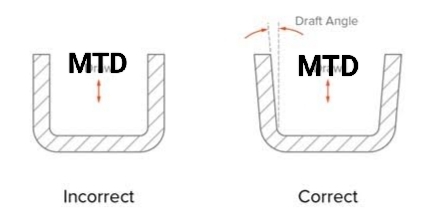Reasons for Drafts:
1. Easier Mold Release:
During injection molding, the plastic part cools and shrinks slightly, which can cause it to stick to the mold surfaces. A draft angle (a slight taper) allows the part to be released without damaging the part or the mold.
2. Prevents Part Damage:
Without a draft, the part may experience scratches, warping, or deformation during ejection from the mold.
3. Reduces Ejection Force:
A draft reduces the friction between the part and the mold, requiring less force to eject the part.
4. Improves Surface Finish:
Proper drafts ensure the part comes out smoothly, avoiding drag marks or defects on the surface.
5. Extends Mold Life:
By reducing the wear and tear during ejection, drafts help extend the mold's lifespan.
---
Why Minimum Draft Values?
1. Dimensional Accuracy:
Excessive draft angles can alter the intended dimensions of the part, especially in areas where precision is critical.
2. Aesthetic Requirements:
Overly large drafts might affect the design or appearance of the part, leading to customer dissatisfaction.
3. Functional Fit:
Parts with excessive drafts might not fit well with other components in assemblies.
4. Material Properties:
Some plastics shrink more than others. A minimum draft angle should consider the material's shrinkage rate to balance ease of ejection with the part's integrity.
---
Typical Minimum Draft Angles:
General rule: 0.5° to 2° is sufficient for most plastic parts.
Texture considerations: For textured surfaces, drafts of 3° or more may be required to prevent sticking.
By designing with the correct minimum draft angle, manufacturers can ensure efficient production, maintain quality, and reduce costs.

No comments:
Post a Comment